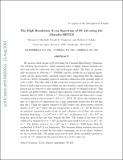The High-Resolution X-Ray Spectrum of SS 433 Using the Chandra HETGS
Author(s)
Canizares, Claude R.; Schulz, Norbert S.; Marshall, Herman
DownloadCanizares_High resolution.pdf (451.3Kb)
PUBLISHER_POLICY
Publisher Policy
Article is made available in accordance with the publisher's policy and may be subject to US copyright law. Please refer to the publisher's site for terms of use.
Terms of use
Metadata
Show full item recordAbstract
We present observations of SS 433 using the Chandra High Energy Transmission Grating Spectrometer. Many emission lines of highly ionized elements are detected with relativistic blue and red Doppler shifts. The lines are measurably broadened to 1700 km s[superscript -1] (FWHM), and the widths do not depend significantly on the characteristic emission temperature, suggesting that the emission occurs in a freely expanding region of constant collimation with an opening angle of 1[° over .]23 ± 0[° over .]06. The blueshifts of lines from low-temperature gas are the same as those of high-temperature gas within the uncertainties, again indicating that the hottest gas we observe to emit emission lines is already at terminal velocity. This velocity is 0.2699 ± 0.0007c, which is larger than the velocity inferred from optical emission lines by 2920 ± 440 km s[superscript -1]. Fits to the emission-line fluxes give a range of temperatures in the jet from 5 × 10[superscript 6] to 1 × 10[superscript 8] K. We derive the emission measure as a function of temperature for a four-component model that fits the line flux data. Using the density-sensitive Si XIII triplet, the characteristic electron density is 10[superscript 14] cm[superscript -3], where the gas temperature is about 1.3 × 10[superscript 7] K. Based on an adiabatic expansion model of the jet and a distance of 4.85 kpc, the electron densities drop from ~2 × 10[superscript 15] to 4 × 10[superscript 13] cm[superscript -3] at distances of (2-20) × 10[superscript 10] cm from the apex of the cone that bounds the flow. The radius of the base of the visible jet is estimated to be ~10[superscript 8] cm, and the mass outflow rate is 1.5 × 10[superscript -7] M[subscript ☉] yr[superscript -1]. The kinetic power is 3.2 × 1038 ergs s[superscript -1], which is 1000 times larger than the unabsorbed 2-10 keV X-ray luminosity. The bremsstrahlung emission associated with the lines can account for the entire continuum; we see no direct evidence for an accretion disk. The image from zeroth order shows extended emission at a scale of ~2'', aligned in the general direction of the radio jets.
Date issued
2002-01Department
MIT Kavli Institute for Astrophysics and Space ResearchJournal
Astrophysical Journal
Publisher
IOP Publishing
Citation
Marshall, Herman L., Claude R. Canizares, and Norbert S. Schulz. “The High‐Resolution X‐Ray Spectrum of SS 433 Using the Chandra HETGS.” The Astrophysical Journal 564.2 (2002): 941–952. © 2002 IOP Publishing
Version: Author's final manuscript
ISSN
0004-637X
1538-4357